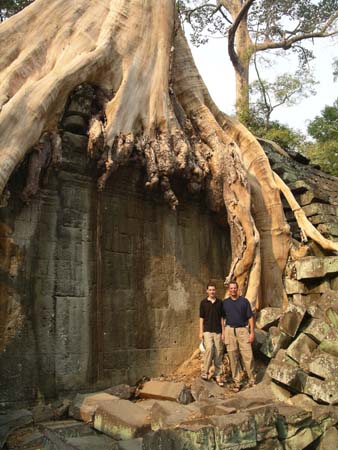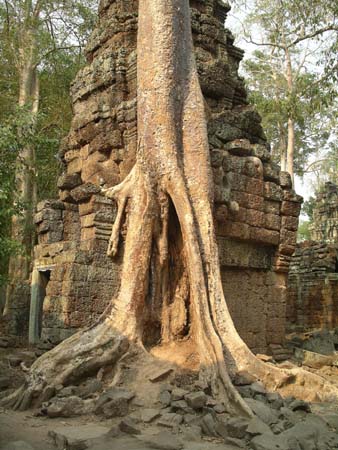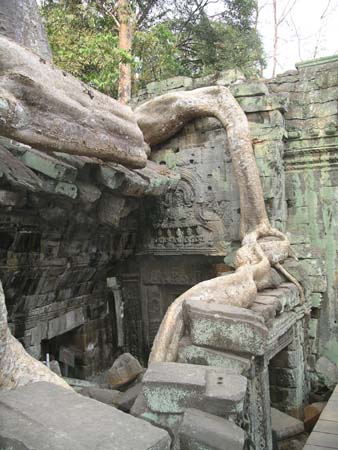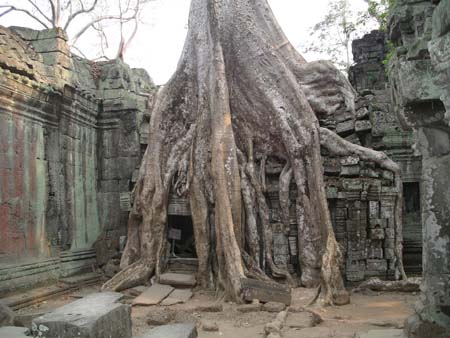Thursday, March 11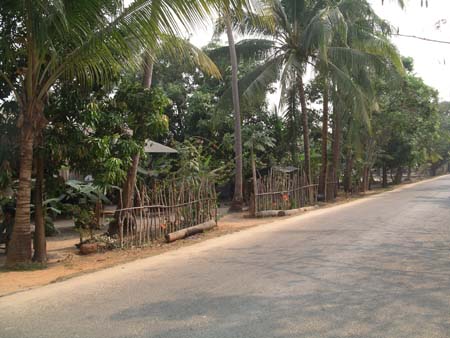
Paula and Steve: Our agenda for the morning was to explore two temples about 25 km from Siem Reap. The journey there was on a recently paved but still very narrow and bumpy road. The best part about a journey of any distance is that it gives us time to talk with our guides about daily life. So as we headed toward Banteay, a 12th century temple, we spoke with Thy about life in Cambodia.
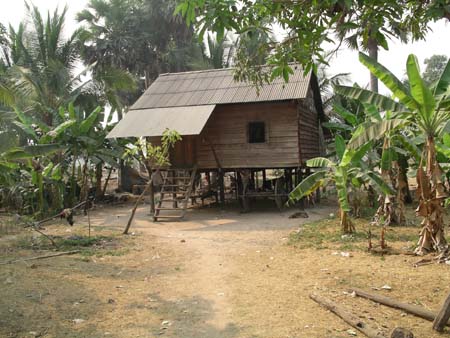 Thy
told us that because of the hot temperatures, most people work in the cities
from 7-11AM and 2-5PM allowing for a break during the heat of the mid-day.
Farmers get started even earlier and work the fields from 5-10AM and then
again from 3-6PM. Most people in Cambodia are farmers and grow rice (one crop
a year during the rainy season), bananas, sugar palm, mango, cashew nuts,
and vegetables. Thy also explained that many Cambodians raise crocodiles,
snakes and have fish farms. Crocodiles and snakes
Thy
told us that because of the hot temperatures, most people work in the cities
from 7-11AM and 2-5PM allowing for a break during the heat of the mid-day.
Farmers get started even earlier and work the fields from 5-10AM and then
again from 3-6PM. Most people in Cambodia are farmers and grow rice (one crop
a year during the rainy season), bananas, sugar palm, mango, cashew nuts,
and vegetables. Thy also explained that many Cambodians raise crocodiles,
snakes and have fish farms. Crocodiles and snakes 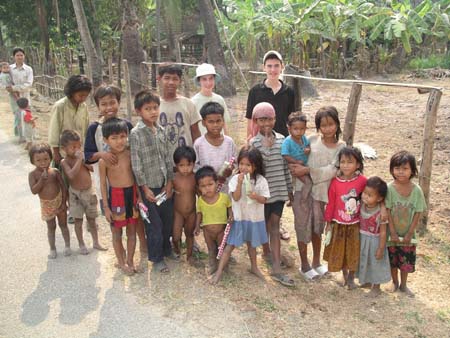 obtain
good prices in the Chinese market. Thy is raising crocodiles and expects to
make a handsome return by selling them when they are five years old (each
one will fetch $2,000!).
obtain
good prices in the Chinese market. Thy is raising crocodiles and expects to
make a handsome return by selling them when they are five years old (each
one will fetch $2,000!).
We stopped along the way at one of the many villages that lined the road
we were traveling. Here we visited several homes. In one household, we watched
as a woman stirred nectar from a sugar palm over a hot fire to make palm sugar.
This process was similar 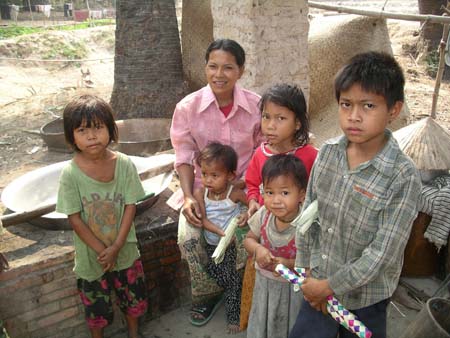 to
what we saw done in Thailand with coconuts but the nectar was even sweeter.
This woman told us that she also has a small rice farm and vegetable garden
as well as pigs and cows. Her five children all gathered around her as she
worked. Thy told us that most rural families are still quite large (7-10 children)
and that although the government is encouraging birth control, most families
are just not interested.
to
what we saw done in Thailand with coconuts but the nectar was even sweeter.
This woman told us that she also has a small rice farm and vegetable garden
as well as pigs and cows. Her five children all gathered around her as she
worked. Thy told us that most rural families are still quite large (7-10 children)
and that although the government is encouraging birth control, most families
are just not interested.
At another home, we saw the family drawing water from a deep well. The water
is not only for bathing and cooking but is also used for drinking. We have
read that many of the people here lack safe drinking water. Thy told us that
the villages don't have electricity but use batteries to generate some power.
A few people have TV but there are no satellite dishes, so they are limited to Cambodian stations.
but there are no satellite dishes, so they are limited to Cambodian stations.
We passed by several schools and had hoped to visit but schools are closed here on Thursdays. Thy told us that school is required for six years starting at age 6 and that some children will go on to junior and secondary schools. Only a few go to the university. Most children here stop after 12 years of age and focus on farming.
Thy told us that the average income for Cambodians is $200/year. This is slightly higher than in Laos, but is still very low. 80% of the population is engaged in farming activities.
As we drove we began to notice how the terrain differed from what we had
expected. The area is flat and scrubby, and does not appear 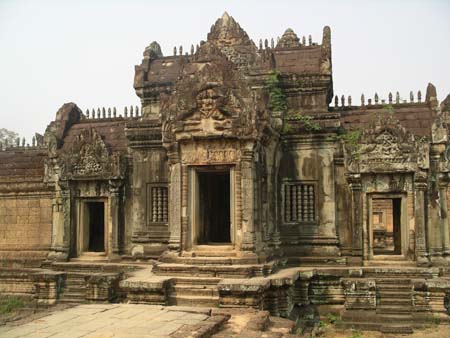 very
fertile. We did see areas of dense jungle but these were in low lying plains.
Thy explained that while Cambodia does have mountains along both of its east
and western borders, most of the country is flat. Only about one third is
covered in the dense jungle we often associate with Cambodia.
very
fertile. We did see areas of dense jungle but these were in low lying plains.
Thy explained that while Cambodia does have mountains along both of its east
and western borders, most of the country is flat. Only about one third is
covered in the dense jungle we often associate with Cambodia.
As we arrived at the Banteay Samre temple, Thy explained that tourists have
only recently been able to travel here safely because the area was occupied
by the Khmer Rouge until 1998. As recently as 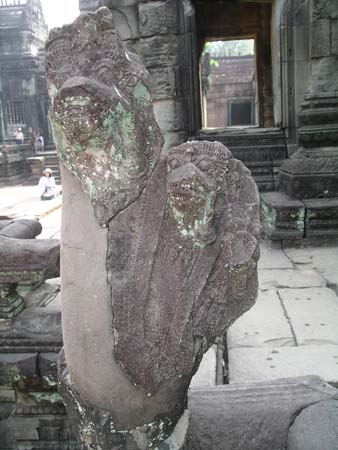 1994,
a tourist and guide were killed by the Khmer Rouge in route to this temple.
The Banteay Samre was built in the 12th century and was originally a Hindu
temple. Like all the temples we have seen so far, it later became a Buddhist
temple and we were able to see areas where stones and reliefs had been altered
to change the temple to the prevailing beliefs.
1994,
a tourist and guide were killed by the Khmer Rouge in route to this temple.
The Banteay Samre was built in the 12th century and was originally a Hindu
temple. Like all the temples we have seen so far, it later became a Buddhist
temple and we were able to see areas where stones and reliefs had been altered
to change the temple to the prevailing beliefs.
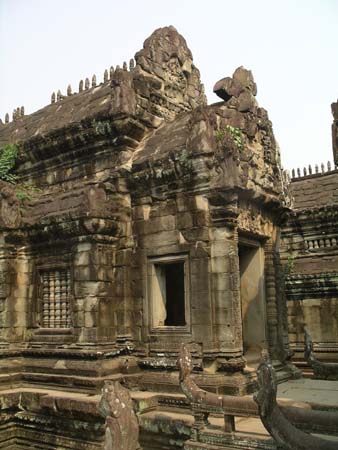 One
thing we enjoyed about this temple was the many statutes and carving of cobra
snakes. Thy told us that the cobra is still quite prevalent in the jungles
here. This temple was also thought to have many treasures of gold and jewels
which were probably looted by locals and the Vietnamese during war times.
One
thing we enjoyed about this temple was the many statutes and carving of cobra
snakes. Thy told us that the cobra is still quite prevalent in the jungles
here. This temple was also thought to have many treasures of gold and jewels
which were probably looted by locals and the Vietnamese during war times.
Before leaving this temple, we stopped to talk with a man one leg who was
selling souvenirs. He told us that he lost his leg in 1985 when he stepped
on a landmine while 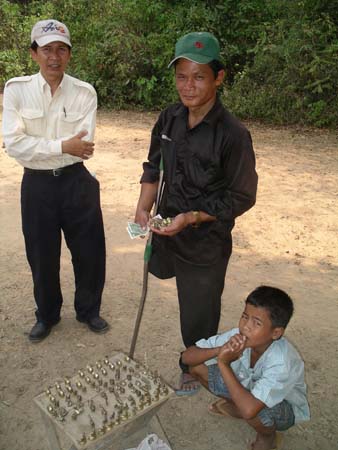 walking
in a water-filled canal to check his fish trap. He said that if the mine hadn't
been underwater, he wouldn't have survived. After purchasing a few items,
we talked more to Thy about the landmines. He told us that while the ones
around Angkor have been removed, there are still 1-2 million in the northern
part of Cambodia. Thy told us that he has seen hundreds of mines over the
course of his life - some even in the past few years. While we didn't see
much evidence of people with disabilities from landmines in Laos or Vietnam,
we have already seen many examples in our two days here.
walking
in a water-filled canal to check his fish trap. He said that if the mine hadn't
been underwater, he wouldn't have survived. After purchasing a few items,
we talked more to Thy about the landmines. He told us that while the ones
around Angkor have been removed, there are still 1-2 million in the northern
part of Cambodia. Thy told us that he has seen hundreds of mines over the
course of his life - some even in the past few years. While we didn't see
much evidence of people with disabilities from landmines in Laos or Vietnam,
we have already seen many examples in our two days here.
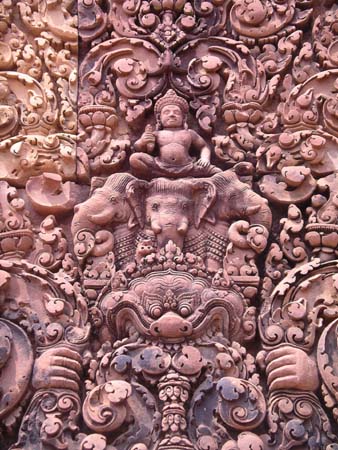 We
then stopped at another small temple, called Banteay Srei. This temple was
built in 967AD, and has beautiful carvings. It was thought to be built by
women, and was dedicated to the Hindu god Shiva.
We
then stopped at another small temple, called Banteay Srei. This temple was
built in 967AD, and has beautiful carvings. It was thought to be built by
women, and was dedicated to the Hindu god Shiva.
After lunch and a swim back at the hotel, we set out to explore the temple
of Ta Prohm, often referred to as the "Jungle Temple." As we approached
the entrance to the temple, it was easy to see why it has been given this
nickname. A decision has been made not to restore or rebuild any parts of
the Ta Prohm - it has been left exactly as it was found when discovered by
the French in the 1860's. 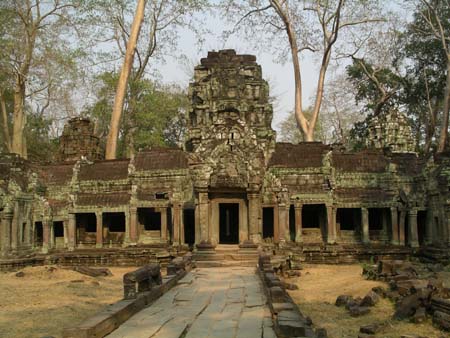 Additionally,
this is the only temple in the area that was not disturbed at all during Cambodia's
recent wars.
Additionally,
this is the only temple in the area that was not disturbed at all during Cambodia's
recent wars.
As a result, the temple is set in a jungle-like setting, with huge trees
slowly crushing many of the walls and structures inside. The roots of these
trees are absolutely amazing, and we took several pictures showing how they
have grown throughout the temple. Additionally, parts of the temple are scattered
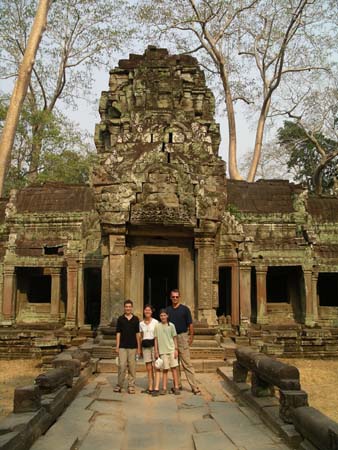 throughout
the grounds, the result of natural decay throughout the centuries.
throughout
the grounds, the result of natural decay throughout the centuries.
We absolutely loved walking through the temple and its ruins, and stared
in awe at how the jungle seems to be strangling the remaining buildings. Everywhere
we looked we saw massive trees and roots growing and suffocating the temple.
We couldn't stop 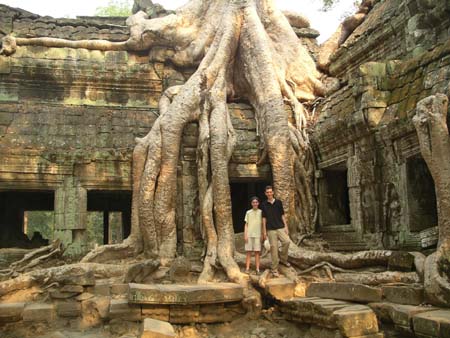 taking
pictures! One particularly impressive part of this temple was used in the
filming of the movie "Tomb Raiders".
taking
pictures! One particularly impressive part of this temple was used in the
filming of the movie "Tomb Raiders".
Our final stop today was at the Phnom Bakheng Temple, called the "Mountain
Temple." This temple is the oldest temple in the Angkor area and sits
on top of a small mountain located just west of Angkor Wat. It was built in
902AD, and is dedicated to the Hindu god Shiva. The temple provides 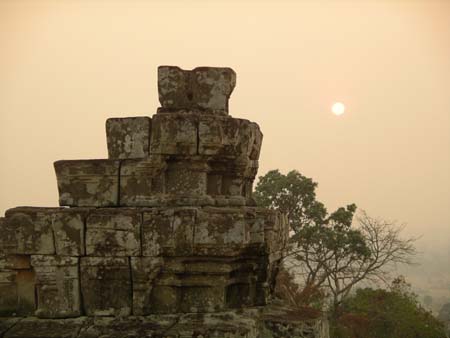 spectacular
views of the sunset and the entire Angkor area. The smoky skies (due to the
burning of leaves) detracted somewhat from our view, but the setting was still
beautiful.
spectacular
views of the sunset and the entire Angkor area. The smoky skies (due to the
burning of leaves) detracted somewhat from our view, but the setting was still
beautiful. 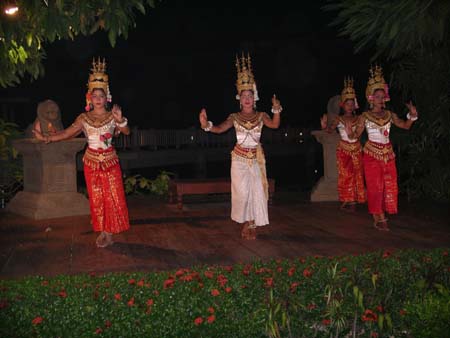 Unfortunately,
this has become very popular with tourists, and the top of the mountain was
filled with people who had made the steep climb up.
Unfortunately,
this has become very popular with tourists, and the top of the mountain was
filled with people who had made the steep climb up.
This evening we enjoyed a Cambodian barbecue dinner at our hotel, including a performance of traditional Cambodian dance.
Tomorrow we'll complete our circuit of Angkor temples with a visit to the most famous of all - Angkor Wat!
